Katey Schultz's Blog, page 13
November 20, 2014
Read Local, Shop Local
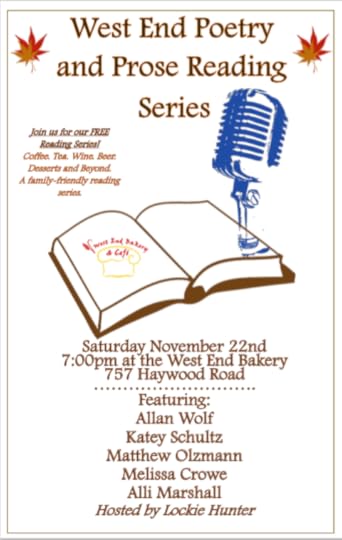 I'm delighted to announce that I've been asked to participate in two local author events this holiday season. Whether you're a Black Friday shopper or a Black Friday protestor...whether you get amped about Small Business Saturday or prefer to stay home and order on Amazon, I believe these opportunities are family friendly, free, and worthwhile. I also believe they're in the spirit of encouraging locals artists and independent entrepreneurs, and no matter who you are, how you vote, or who gets your cash, there's no harm in this. No harm at all! Come on out, if you're in the area and if you're not, consider a similar option in your neck of the woods. It's time to be thankful for what makes where we live unique, and artists and entrepreneurs are part of that.
I'm delighted to announce that I've been asked to participate in two local author events this holiday season. Whether you're a Black Friday shopper or a Black Friday protestor...whether you get amped about Small Business Saturday or prefer to stay home and order on Amazon, I believe these opportunities are family friendly, free, and worthwhile. I also believe they're in the spirit of encouraging locals artists and independent entrepreneurs, and no matter who you are, how you vote, or who gets your cash, there's no harm in this. No harm at all! Come on out, if you're in the area and if you're not, consider a similar option in your neck of the woods. It's time to be thankful for what makes where we live unique, and artists and entrepreneurs are part of that.To that end, check out the West End Poetry & Prose Reading Series--where I'll read part of Flashes of War's "Into Pure Bronze" (the soccer story!) and eagerly anticipate the creative work of other area authors.
I'll also be signing books at Malaprop's Bookstore in downtown Asheville. This is the bookstore that launched Flashes of War 18 months ago to the warmest, most supportive crowd I have ever known. As a part of Small Business Saturday and Indies First, the bookstore has invited authors to sign books and "talk up" two other books that they recommend to shoppers. I'll be promoting Mary Kay Zuvraleff's Man Alive! and Hemingway's In Our Time, and will be sigining from 1-3pm on Saturday, November 29th.
Published on November 20, 2014 05:00
November 17, 2014
Jogging Writer: Testing for 10K
Last week, I realized I had a schedule conflict with my December 14th 10K Race Day and began a frantic search for another race. Thankfully, I found one even closer to home that's just one week earlier, bumping up race day to December 6th at a nearby wooded, private park. Now, I'll race along rolling single track trail as opposed to a low-elevation city sidewalk, likely slowing me down. The race is also a week earlier, cutting into my already shortened training schedule.
Time to reassess. I pulled out Michael Fitzgerald's 80/20 Running, complete with training regimens for the 5K, 10K, Half Marathon, and Marathon. I've been working the Level 1 training session for my first-ever 10K, which Fitzgerald says should take about 12 weeks. To make things work, I'd cut the 12 weeks down to 10, reducing my "base" training phase by 2 weeks. This felt easy enough to do on the heals of running my first 5K. But now, that regimen is shortened to 9 weeks, cutting into both my "peak" and "taper" phases. As I looked at the table, charts and journals spread out before me, I filled with a sense of dread.
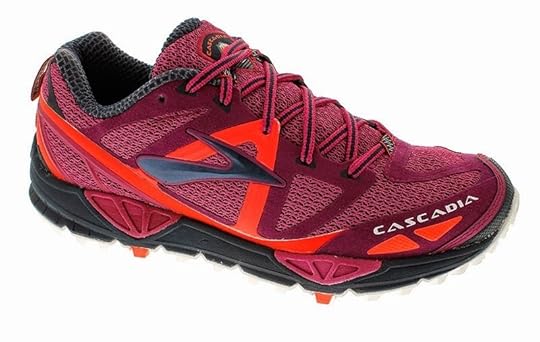 Brooks Cascadia 9: What I run in for stability,
Brooks Cascadia 9: What I run in for stability,
performance, comfort, and durability.How would I know what my true running pace was, after so many weeks training slowly and using a heart rate activity tracker? What if I started out too fast? What if I went slower than I needed to? I glanced again at Fitzgerald's training runs, and then out the window. It was a glorious, crisp, sunny November day with temperatures in the upper 30's. I ate a quick snack, stretched, waited to digest, watched the thermometer reach 40, and headed out the door. Time for a test run.
To be clear: Up until a few months ago, I never aspired to be "a runner" or enter races. Having played sports all my life, I certainly have a competitive edge in me but I've never felt I had the speed or natural physique for successful running. Fitzgerald's book changed all of that for me, along with some other timing and life factors that seemed to click into place. All of which is to say, the first time I realized I might be able to run a 10K was when I accidentally ran over six miles on an afternoon run in Celo. Thanks to my FitBit pedometer, I knew I'd run 6.2 miles...and I felt tired, but happy. If I could do that without even knowing it, maybe I could improve my time. Maybe, just maybe, I could even run a half marathon.
That first accident was in early August 2014. I ran 6.2 miles in 80 minutes that day--leisurely, unaware, the bliss of ignorance on my side. A week later, curious and testing myself, I ran the same route in 72 minutes. Then I went backpacking, got plantar fasciatis, trained for a 5K anyway, raced the 5K, registered for a 10K, had to find a different race, and here we are...just 3 weeks to showtime.
Armed with my FitBit (to determine distance) and my HeartQ (to monitor my heart as I "searched" for my "natural" pace), I started the timer, kicked up my heels, and took off. The FitBit pedometer isn't exactly easy to check while in motion and I'm not too much of a gearhead anyway, so I made a promise to myself I'd only check it when I had to. At what I imagined was about the halfway point, I fiddled with the FitBit and figured out I had already run 3.1 miles--a 5K. Then I looked at my watch and realized I'd run the 5K in 34 minutes (it included a lot of uphill)--just 1min45secs slower than my 5K race time.
I think I must have half-yelped and half-jumped when I realized my mistake--I was running my 10K at near the same pace as my 5K. Determined I would be doomed, I pressed on without slowing my pace. If I had already fried most of my calorie and muscle reserves, I might as well keep going (BPM 184) and see how long I could keep it up. If that meant I drastically slowed at mile 4 or mile 5, so be it. I'd still finish my test run and have useful data.
But I never slowed. Coaxed ahead by the thought that I could actually keep running at that pace, if I just pushed a little more through any fatigue, I simply refused to let myself slow down. Thankfully, all my joints and muscles cooperated. And 5 weeks into Fitgerald's 80/20 running plan, his advice seemed to be working--I was, in fact, running faster and easier even though my training was slower and longer. When I finally hit 6.2 miles and pressed STOP on my watch, I was overjoyed at the time: I'd run a 10K in 67:54, a whole 4 minutes and 6 seconds faster than before.
I don't know that I can replicate that on race day, but I do know I have a new PR (personal record) and a much clearer sense for how long I can run at what pace. I don't intend to wear any gear on race day. I don't want to be distracted. But the memory of that spontaneous test run will carry me far, I believe, and if I can keep my 10K time on race day to 70 minutes or below, I'll be feeling pretty good. Fingers crossed!
Time to reassess. I pulled out Michael Fitzgerald's 80/20 Running, complete with training regimens for the 5K, 10K, Half Marathon, and Marathon. I've been working the Level 1 training session for my first-ever 10K, which Fitzgerald says should take about 12 weeks. To make things work, I'd cut the 12 weeks down to 10, reducing my "base" training phase by 2 weeks. This felt easy enough to do on the heals of running my first 5K. But now, that regimen is shortened to 9 weeks, cutting into both my "peak" and "taper" phases. As I looked at the table, charts and journals spread out before me, I filled with a sense of dread.
 Brooks Cascadia 9: What I run in for stability,
Brooks Cascadia 9: What I run in for stability,performance, comfort, and durability.How would I know what my true running pace was, after so many weeks training slowly and using a heart rate activity tracker? What if I started out too fast? What if I went slower than I needed to? I glanced again at Fitzgerald's training runs, and then out the window. It was a glorious, crisp, sunny November day with temperatures in the upper 30's. I ate a quick snack, stretched, waited to digest, watched the thermometer reach 40, and headed out the door. Time for a test run.
To be clear: Up until a few months ago, I never aspired to be "a runner" or enter races. Having played sports all my life, I certainly have a competitive edge in me but I've never felt I had the speed or natural physique for successful running. Fitzgerald's book changed all of that for me, along with some other timing and life factors that seemed to click into place. All of which is to say, the first time I realized I might be able to run a 10K was when I accidentally ran over six miles on an afternoon run in Celo. Thanks to my FitBit pedometer, I knew I'd run 6.2 miles...and I felt tired, but happy. If I could do that without even knowing it, maybe I could improve my time. Maybe, just maybe, I could even run a half marathon.
That first accident was in early August 2014. I ran 6.2 miles in 80 minutes that day--leisurely, unaware, the bliss of ignorance on my side. A week later, curious and testing myself, I ran the same route in 72 minutes. Then I went backpacking, got plantar fasciatis, trained for a 5K anyway, raced the 5K, registered for a 10K, had to find a different race, and here we are...just 3 weeks to showtime.
Armed with my FitBit (to determine distance) and my HeartQ (to monitor my heart as I "searched" for my "natural" pace), I started the timer, kicked up my heels, and took off. The FitBit pedometer isn't exactly easy to check while in motion and I'm not too much of a gearhead anyway, so I made a promise to myself I'd only check it when I had to. At what I imagined was about the halfway point, I fiddled with the FitBit and figured out I had already run 3.1 miles--a 5K. Then I looked at my watch and realized I'd run the 5K in 34 minutes (it included a lot of uphill)--just 1min45secs slower than my 5K race time.
I think I must have half-yelped and half-jumped when I realized my mistake--I was running my 10K at near the same pace as my 5K. Determined I would be doomed, I pressed on without slowing my pace. If I had already fried most of my calorie and muscle reserves, I might as well keep going (BPM 184) and see how long I could keep it up. If that meant I drastically slowed at mile 4 or mile 5, so be it. I'd still finish my test run and have useful data.
But I never slowed. Coaxed ahead by the thought that I could actually keep running at that pace, if I just pushed a little more through any fatigue, I simply refused to let myself slow down. Thankfully, all my joints and muscles cooperated. And 5 weeks into Fitgerald's 80/20 running plan, his advice seemed to be working--I was, in fact, running faster and easier even though my training was slower and longer. When I finally hit 6.2 miles and pressed STOP on my watch, I was overjoyed at the time: I'd run a 10K in 67:54, a whole 4 minutes and 6 seconds faster than before.
I don't know that I can replicate that on race day, but I do know I have a new PR (personal record) and a much clearer sense for how long I can run at what pace. I don't intend to wear any gear on race day. I don't want to be distracted. But the memory of that spontaneous test run will carry me far, I believe, and if I can keep my 10K time on race day to 70 minutes or below, I'll be feeling pretty good. Fingers crossed!
Published on November 17, 2014 05:00
November 6, 2014
Stories that Travelled Far
Thirteen months after 4 stories from Flashes of War were reprinted in 2 issues Afghan Scene Magazine (the only English printed magazine in the country; 8,000 subscribers), my contributor's copies arrived from FedEx via the United Arab Emirates. It's a beautiful publication and I found it fascinating to see which lines from the stories the editors highlighted (view close up pic). My mind had to travel really far to write these stories and they ended up being shared in a place I care very much about. Now, they've found their way back to me in this special publication.
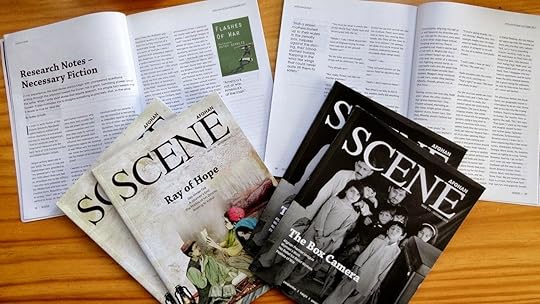
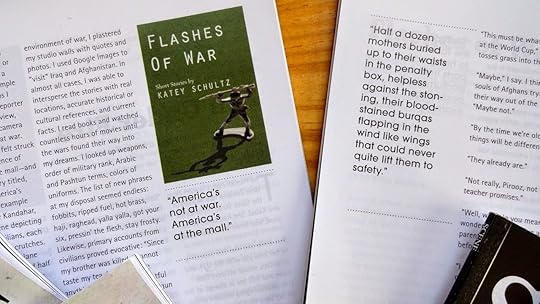 Holding these in my hand also reminded me of something else that came my way from Afghanistan not long after the book was released. Five copies of the book were mailed to a BBC contact in Kabul who then brought the books to a trustworthy bookseller there (many books are apparently photocopied and sellers make money of the photocopies--honestly though, if people are reading, I'm pretty happy about that either way). Later, a friend request from an Afghan man in Kabul came my way, and along with it this photograph:
Holding these in my hand also reminded me of something else that came my way from Afghanistan not long after the book was released. Five copies of the book were mailed to a BBC contact in Kabul who then brought the books to a trustworthy bookseller there (many books are apparently photocopied and sellers make money of the photocopies--honestly though, if people are reading, I'm pretty happy about that either way). Later, a friend request from an Afghan man in Kabul came my way, and along with it this photograph:
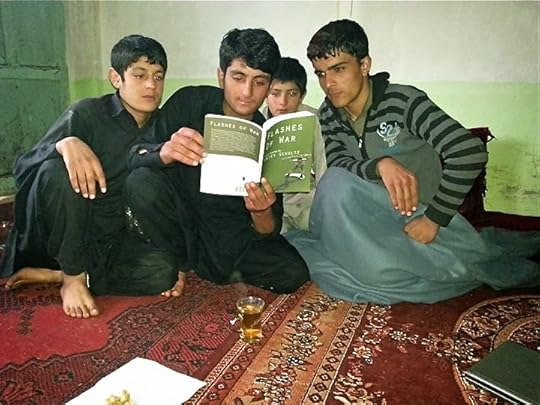

 Holding these in my hand also reminded me of something else that came my way from Afghanistan not long after the book was released. Five copies of the book were mailed to a BBC contact in Kabul who then brought the books to a trustworthy bookseller there (many books are apparently photocopied and sellers make money of the photocopies--honestly though, if people are reading, I'm pretty happy about that either way). Later, a friend request from an Afghan man in Kabul came my way, and along with it this photograph:
Holding these in my hand also reminded me of something else that came my way from Afghanistan not long after the book was released. Five copies of the book were mailed to a BBC contact in Kabul who then brought the books to a trustworthy bookseller there (many books are apparently photocopied and sellers make money of the photocopies--honestly though, if people are reading, I'm pretty happy about that either way). Later, a friend request from an Afghan man in Kabul came my way, and along with it this photograph:
Published on November 06, 2014 05:00
November 3, 2014
Jogging Writer: Top Pick Heart Rate Monitor
Ok. I'll admit it. I'm getting a little gear-crazy. I'm not busting the bank or anything...but I've read 3 running books in the last month and started calculating my five heart rate zones according to Matt Fitgerald's 80/20 Running book. I bought my Brooks Cascadia (on discount) based on gear reviews in Outside Magazine. A new body fat percentage scale is on its way via Amazon Prime and I've logged 3 weeks of official Level 1 training for my 10K (race day: December 14). Perhaps more surprising than any other gear purchase has been my new HeartQ Heart Rate monitor sports watch and activity tracker. We all know about target heart rates, but Fitzgerald's book makes a powerful case for thinking outside that box and demonstrates how endurance athletes have run slower and longer for years and years and still yielded personal best times on race day.
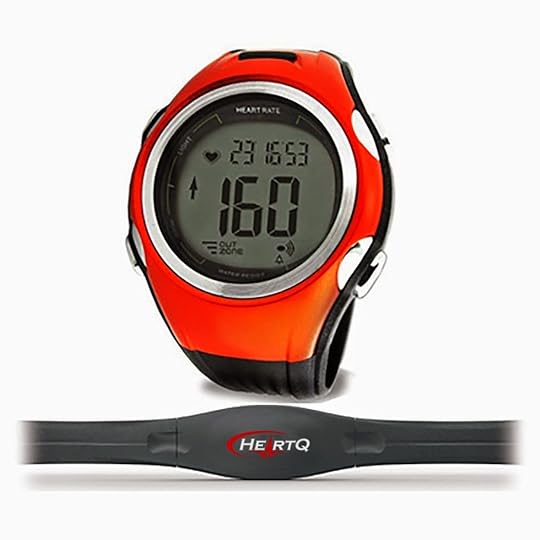 My lactate threshold--the heart rate just about where I can run and carry on a conversation--is 175 beats per minute. This means my Zone 1 and Zone 2 training, according to Fitzgerald, are significantly lower--and slower--than I would have guessed. In order to make sure I'm running slow enough, and therefore able to run long enough, to achieve my desired training goals, I've got to go slow and steady. My new best friend, the HQ, beeps at me if I get above or below zone. Typically, after 5-10 minutes in one of the zones, my body and mind find the natural pace and the watch stops beeping. When a car drives by or a dog barks, I've noticed, my heart rate quickens and will sometimes momentarily kick the HQ rating higher and take me out of the zone, making the watch beep. I slow my pace for a beat or two, get back into the zone, and continue. At the end of my workout, I can track my average heart rate, the number of minutes I spent in the zone (this is crucial on Fitzgerald's plan, as a certain number of minutes in each zone is the crux of the training program), the calories burned, and more.
My lactate threshold--the heart rate just about where I can run and carry on a conversation--is 175 beats per minute. This means my Zone 1 and Zone 2 training, according to Fitzgerald, are significantly lower--and slower--than I would have guessed. In order to make sure I'm running slow enough, and therefore able to run long enough, to achieve my desired training goals, I've got to go slow and steady. My new best friend, the HQ, beeps at me if I get above or below zone. Typically, after 5-10 minutes in one of the zones, my body and mind find the natural pace and the watch stops beeping. When a car drives by or a dog barks, I've noticed, my heart rate quickens and will sometimes momentarily kick the HQ rating higher and take me out of the zone, making the watch beep. I slow my pace for a beat or two, get back into the zone, and continue. At the end of my workout, I can track my average heart rate, the number of minutes I spent in the zone (this is crucial on Fitzgerald's plan, as a certain number of minutes in each zone is the crux of the training program), the calories burned, and more.
So I have to wear a watch when I prefer not to. So I have to wear a chest strap (I can hardly tell it's there). These are small prices to pay given the immediate feedback I get and the power that a few little numbers have to help me gain confidence and achieve my goals. The HeartQ buttons are big and easy to push, the watch is programmable if you want to adjust the set heart rate levels, and--here's the real kicker--there are real human beings managing the small company's email account and they write back to you. Like with real, helpful feedback and information. Customer service and a good product? I'm sold.
Today is the start of Week 4 of my Level 1 training and even though I still feel like I have to "hold myself back" on most of my runs, I can feel myself getting stronger and my endurance deepening. What will I discover next? Maybe the world's best running socks or the most motivating iPod playlist in history. Time will tell...stay tuned for occasional dispatches from the The Jogging Writer.
 My lactate threshold--the heart rate just about where I can run and carry on a conversation--is 175 beats per minute. This means my Zone 1 and Zone 2 training, according to Fitzgerald, are significantly lower--and slower--than I would have guessed. In order to make sure I'm running slow enough, and therefore able to run long enough, to achieve my desired training goals, I've got to go slow and steady. My new best friend, the HQ, beeps at me if I get above or below zone. Typically, after 5-10 minutes in one of the zones, my body and mind find the natural pace and the watch stops beeping. When a car drives by or a dog barks, I've noticed, my heart rate quickens and will sometimes momentarily kick the HQ rating higher and take me out of the zone, making the watch beep. I slow my pace for a beat or two, get back into the zone, and continue. At the end of my workout, I can track my average heart rate, the number of minutes I spent in the zone (this is crucial on Fitzgerald's plan, as a certain number of minutes in each zone is the crux of the training program), the calories burned, and more.
My lactate threshold--the heart rate just about where I can run and carry on a conversation--is 175 beats per minute. This means my Zone 1 and Zone 2 training, according to Fitzgerald, are significantly lower--and slower--than I would have guessed. In order to make sure I'm running slow enough, and therefore able to run long enough, to achieve my desired training goals, I've got to go slow and steady. My new best friend, the HQ, beeps at me if I get above or below zone. Typically, after 5-10 minutes in one of the zones, my body and mind find the natural pace and the watch stops beeping. When a car drives by or a dog barks, I've noticed, my heart rate quickens and will sometimes momentarily kick the HQ rating higher and take me out of the zone, making the watch beep. I slow my pace for a beat or two, get back into the zone, and continue. At the end of my workout, I can track my average heart rate, the number of minutes I spent in the zone (this is crucial on Fitzgerald's plan, as a certain number of minutes in each zone is the crux of the training program), the calories burned, and more.So I have to wear a watch when I prefer not to. So I have to wear a chest strap (I can hardly tell it's there). These are small prices to pay given the immediate feedback I get and the power that a few little numbers have to help me gain confidence and achieve my goals. The HeartQ buttons are big and easy to push, the watch is programmable if you want to adjust the set heart rate levels, and--here's the real kicker--there are real human beings managing the small company's email account and they write back to you. Like with real, helpful feedback and information. Customer service and a good product? I'm sold.
Today is the start of Week 4 of my Level 1 training and even though I still feel like I have to "hold myself back" on most of my runs, I can feel myself getting stronger and my endurance deepening. What will I discover next? Maybe the world's best running socks or the most motivating iPod playlist in history. Time will tell...stay tuned for occasional dispatches from the The Jogging Writer.
Published on November 03, 2014 05:00
October 29, 2014
Finding Fall
Yesterday, Brad and I took a mid-afternoon break to climb one of the hills at Mercy Me.
"Look!" I said, pointing to the steep slope above the shooting range. "There's Fall! Right over there!" I dashed through the field, brushing pods of milkweed that sent late-season fluff into the air.
"Really?" said Brad. He chased after me.
"Really," I said. "I promise. That's Fall. I can see it. I don't know where Winter is and I don't know about Spring, but I know Fall when I see it." This is what we do: speaking in hyperbole, asserting ecstatic proclamations ranging from absurd to juvenile, making a big deal over something as ordinary as the hill Brad stared at every day of his childhood.
"How do we get there?" Brad asked.
"Straight through!" I plunged into a tangle of branches and vines, leaves crunching underfoot. Like explorers, we were off and running.
Still in the Appalachian Mountains, our home here is quite similar to Celo in terms of the ecosystem and the geographic features. Mixed hardwood forest unfurls over smooth-topped hills and mountains, clay-like soil and abundant undergrowth doing their job to keep the compost barrel of Mother Nature churning. The highest mountains in the East aren't at our back door, but I take heart in the fact that it's still the same string of mountains--just a little less dramatic.
At the top of the hill, we lay down in the piles of leaves and looked up. Pin oaks and hickory trees rose high into the sky, brilliant yellow leaves a-flame. A gust of wind rolled over the hill, shaking the trees. Rainbows of color rained down.
"First one to catch a leaf wins!" said Brad.
That's harder than it sounds. It's also harder than it sounds to be away from a land you love...even if it's only two hours away by car. What can I say? I have stories in the Black Mountains and I can see my way through them each time I look out my window, walk the dog, or stare at the ridge line of the Blacks cutting across the sky. I used to be really good at forging new stories, exploring new places as soon as my feet hit the ground. Now, all my energy for story goes into the novel, as it should. The idea of learning a new place exhausts me, the task daunting because I'd insist on doing it with my previous degree of research and specificity.
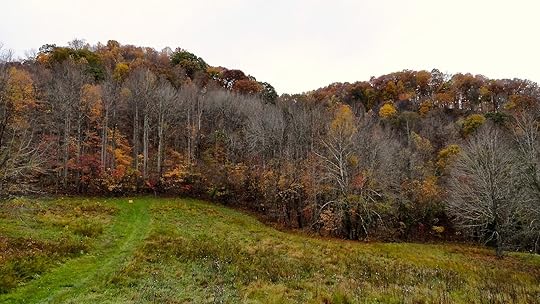 (steeper than they look)
(steeper than they look)
Neither Brad nor I could catch a leaf that afternoon, but in time that didn't matter. The forest waved its hands around us. The hill slept beneath our backs. And somewhere on the other side of the holler a train rattled along the river while the neighbor's cattle offered their chorus of moo's. It all felt right, even with the sad stone in my gut that misses home.
We've been putting in long days of supremely focused work. I have somewhere between 80-100 pages on the novel, having started from scratch 7 weeks ago and my business is bringing in more work than I can accept. Brad is officially in the remaining 50% of the degree program that has a 50% failure rate (his program of study is hard!) and continues to receive high marks. Progress for both of us is slow and steady. If we weren't here to point it out to each other, we'd likely miss it on our own. Winter is coming. More time for hunkering down. It's good to be in love, to have such company, to delight in our deepening relationship as we build a new life together one season at a time.
"Look!" I said, pointing to the steep slope above the shooting range. "There's Fall! Right over there!" I dashed through the field, brushing pods of milkweed that sent late-season fluff into the air.
"Really?" said Brad. He chased after me.
"Really," I said. "I promise. That's Fall. I can see it. I don't know where Winter is and I don't know about Spring, but I know Fall when I see it." This is what we do: speaking in hyperbole, asserting ecstatic proclamations ranging from absurd to juvenile, making a big deal over something as ordinary as the hill Brad stared at every day of his childhood.
"How do we get there?" Brad asked.
"Straight through!" I plunged into a tangle of branches and vines, leaves crunching underfoot. Like explorers, we were off and running.
Still in the Appalachian Mountains, our home here is quite similar to Celo in terms of the ecosystem and the geographic features. Mixed hardwood forest unfurls over smooth-topped hills and mountains, clay-like soil and abundant undergrowth doing their job to keep the compost barrel of Mother Nature churning. The highest mountains in the East aren't at our back door, but I take heart in the fact that it's still the same string of mountains--just a little less dramatic.
At the top of the hill, we lay down in the piles of leaves and looked up. Pin oaks and hickory trees rose high into the sky, brilliant yellow leaves a-flame. A gust of wind rolled over the hill, shaking the trees. Rainbows of color rained down.
"First one to catch a leaf wins!" said Brad.
That's harder than it sounds. It's also harder than it sounds to be away from a land you love...even if it's only two hours away by car. What can I say? I have stories in the Black Mountains and I can see my way through them each time I look out my window, walk the dog, or stare at the ridge line of the Blacks cutting across the sky. I used to be really good at forging new stories, exploring new places as soon as my feet hit the ground. Now, all my energy for story goes into the novel, as it should. The idea of learning a new place exhausts me, the task daunting because I'd insist on doing it with my previous degree of research and specificity.
 (steeper than they look)
(steeper than they look)Neither Brad nor I could catch a leaf that afternoon, but in time that didn't matter. The forest waved its hands around us. The hill slept beneath our backs. And somewhere on the other side of the holler a train rattled along the river while the neighbor's cattle offered their chorus of moo's. It all felt right, even with the sad stone in my gut that misses home.
We've been putting in long days of supremely focused work. I have somewhere between 80-100 pages on the novel, having started from scratch 7 weeks ago and my business is bringing in more work than I can accept. Brad is officially in the remaining 50% of the degree program that has a 50% failure rate (his program of study is hard!) and continues to receive high marks. Progress for both of us is slow and steady. If we weren't here to point it out to each other, we'd likely miss it on our own. Winter is coming. More time for hunkering down. It's good to be in love, to have such company, to delight in our deepening relationship as we build a new life together one season at a time.
Published on October 29, 2014 05:00
October 27, 2014
Revising the Novel: A Resource
When I first began drafting the novel in June 2012, I knew only one thing: Write. I had no sense for structure, not sense for balance between flashback and present narrative, and very little understanding of the actual physical and psychological energy drafting a novel requires. I suppose that's good, because I might have held myself back that ignorant summer, cutting the novel off at the cord. I even recall seeking feedback on those early pages. I had to, due to a deadline from an agent. The feedback certainly helped me continue believing in my story, but those early scenes and pages have come so far from their original structure. My friends (who had drafted novels before) thankfully knew better than to provide line-level feedback. They listened for the pulse of the story and they looked for catchy moments that might hook an agent. They were wise to do so.
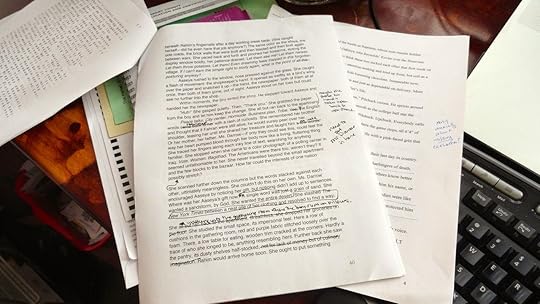 Since then, I've tried to keep my process as transparent as possible--both for myself and for followers of this blog. I needed help drafting my novel and, while I had a lot of support and there were countless "how to" books I could buy, I never found an expose voice that "told all" through the highs and lows and dead ends in between. To that end, today's post is a recap of most my version of these "tell-all's" so far. Searching through my posts over the past few years (I know, I know, I should be "tagging"), I was surprised (and proud!) of how many kernels of advice I'd been able to put together, adding up to something I might even call insight. I hope these provide a resource for others, and I'll continue to title all novel process posts in the future with the subheading "Revising the Novel" for easier searching online. Here goes:The Writing on the WallIncreasing Tension in a NovelLiving Inside a NovelSaying Something You Didn't Know You CouldTaking Time to WonderOn Being Precise and DirectWhen NOT Writing a Novel (to Write a Novel)Put Your Manuscript in a DrawerGetting Back InHow to Revise for DiscoveryTrail Crew of the MindTaking the Time to WonderbookReflections on RevisionThawing Out Your NovelRuts & SubzeroesDon't Look BackWrite Poems InsteadReverse OutliningCharacter & Setting MapsEverything in its PlaceExpanding a SceneLogistics on PaperLogistics on the ScreenSewing, Surgery, & Equations (Part 1)Sewing, Surgery, & Equations (Part 2)The Terrible MiddlesWhat is Your Vision?Knowing When You Need HelpAbsorbing the AdviceIt's Perfectly Normal (to Hate Your Novel)Out of the DrawerFinding a Good ReaderRevision is a Physical ActOn Interruption
Since then, I've tried to keep my process as transparent as possible--both for myself and for followers of this blog. I needed help drafting my novel and, while I had a lot of support and there were countless "how to" books I could buy, I never found an expose voice that "told all" through the highs and lows and dead ends in between. To that end, today's post is a recap of most my version of these "tell-all's" so far. Searching through my posts over the past few years (I know, I know, I should be "tagging"), I was surprised (and proud!) of how many kernels of advice I'd been able to put together, adding up to something I might even call insight. I hope these provide a resource for others, and I'll continue to title all novel process posts in the future with the subheading "Revising the Novel" for easier searching online. Here goes:The Writing on the WallIncreasing Tension in a NovelLiving Inside a NovelSaying Something You Didn't Know You CouldTaking Time to WonderOn Being Precise and DirectWhen NOT Writing a Novel (to Write a Novel)Put Your Manuscript in a DrawerGetting Back InHow to Revise for DiscoveryTrail Crew of the MindTaking the Time to WonderbookReflections on RevisionThawing Out Your NovelRuts & SubzeroesDon't Look BackWrite Poems InsteadReverse OutliningCharacter & Setting MapsEverything in its PlaceExpanding a SceneLogistics on PaperLogistics on the ScreenSewing, Surgery, & Equations (Part 1)Sewing, Surgery, & Equations (Part 2)The Terrible MiddlesWhat is Your Vision?Knowing When You Need HelpAbsorbing the AdviceIt's Perfectly Normal (to Hate Your Novel)Out of the DrawerFinding a Good ReaderRevision is a Physical ActOn Interruption
 Since then, I've tried to keep my process as transparent as possible--both for myself and for followers of this blog. I needed help drafting my novel and, while I had a lot of support and there were countless "how to" books I could buy, I never found an expose voice that "told all" through the highs and lows and dead ends in between. To that end, today's post is a recap of most my version of these "tell-all's" so far. Searching through my posts over the past few years (I know, I know, I should be "tagging"), I was surprised (and proud!) of how many kernels of advice I'd been able to put together, adding up to something I might even call insight. I hope these provide a resource for others, and I'll continue to title all novel process posts in the future with the subheading "Revising the Novel" for easier searching online. Here goes:The Writing on the WallIncreasing Tension in a NovelLiving Inside a NovelSaying Something You Didn't Know You CouldTaking Time to WonderOn Being Precise and DirectWhen NOT Writing a Novel (to Write a Novel)Put Your Manuscript in a DrawerGetting Back InHow to Revise for DiscoveryTrail Crew of the MindTaking the Time to WonderbookReflections on RevisionThawing Out Your NovelRuts & SubzeroesDon't Look BackWrite Poems InsteadReverse OutliningCharacter & Setting MapsEverything in its PlaceExpanding a SceneLogistics on PaperLogistics on the ScreenSewing, Surgery, & Equations (Part 1)Sewing, Surgery, & Equations (Part 2)The Terrible MiddlesWhat is Your Vision?Knowing When You Need HelpAbsorbing the AdviceIt's Perfectly Normal (to Hate Your Novel)Out of the DrawerFinding a Good ReaderRevision is a Physical ActOn Interruption
Since then, I've tried to keep my process as transparent as possible--both for myself and for followers of this blog. I needed help drafting my novel and, while I had a lot of support and there were countless "how to" books I could buy, I never found an expose voice that "told all" through the highs and lows and dead ends in between. To that end, today's post is a recap of most my version of these "tell-all's" so far. Searching through my posts over the past few years (I know, I know, I should be "tagging"), I was surprised (and proud!) of how many kernels of advice I'd been able to put together, adding up to something I might even call insight. I hope these provide a resource for others, and I'll continue to title all novel process posts in the future with the subheading "Revising the Novel" for easier searching online. Here goes:The Writing on the WallIncreasing Tension in a NovelLiving Inside a NovelSaying Something You Didn't Know You CouldTaking Time to WonderOn Being Precise and DirectWhen NOT Writing a Novel (to Write a Novel)Put Your Manuscript in a DrawerGetting Back InHow to Revise for DiscoveryTrail Crew of the MindTaking the Time to WonderbookReflections on RevisionThawing Out Your NovelRuts & SubzeroesDon't Look BackWrite Poems InsteadReverse OutliningCharacter & Setting MapsEverything in its PlaceExpanding a SceneLogistics on PaperLogistics on the ScreenSewing, Surgery, & Equations (Part 1)Sewing, Surgery, & Equations (Part 2)The Terrible MiddlesWhat is Your Vision?Knowing When You Need HelpAbsorbing the AdviceIt's Perfectly Normal (to Hate Your Novel)Out of the DrawerFinding a Good ReaderRevision is a Physical ActOn Interruption
Published on October 27, 2014 05:00
October 23, 2014
Revising the Novel: Interruption
Don't get me wrong...five days on the road with Brad with overnights in Hokie alumni households is a pretty freaking great experience (and conveniently, much of the trip can be written off as a business expense). But man-on-man does that length of time away from the desk wreak havoc on routines.
 Rockville, Maryland. Who knew?
Rockville, Maryland. Who knew?
Here's the good news: First, as indicated by the above photograph, yes, Brad clearly has Zombie potential. It's good to know what I'm marrying into, Zombie-potential being high on the list of priorities for lifelong mates. Second, as indicated by my tone of voice--I don't feel guilty about not working on the novel right before, during, or right after the trip. Which is to say, as much as I missed revising and as much as I hate interrupting my momentum, the fact that I don't feel guilty means that I've finally built enough of my foundation as a novelist-in-progress to trust it will still be there when I come back. There's no fear of the novel getting ripped out from under me. There's no worry that I've interrupted something so gravely, I can't get it back. Rejoice!
With a final push through these next four days (yep, still working 10-hour days), I'll be caught up and ready to deal with my characters Monday morning. And if I'm not caught up? Monday morning is still novel time. No bones about it. The list of things to do between now and Monday morning is long, but I know enough about balance and the writing life now to understand that the list also has to include exercise and unstructured down time if I am to be of any use to my characters. If that means I fall slightly behind on work again, so be it. I'm still meeting my deadlines, so ultimately the only real source of pressure is coming from myself. (What's new?!)
Onward we go, into fall and into the weekend of work...into my growing obsession with training for a 10K...into my novel and its upcoming muddy middle...deeper into love and deeper into life. Can being busy possibly feel this good? Yes, yes it can. The key? Knowing how to balance the equations. I'm still learning how to be my best boss and, ideally, that means not working on weekends. But I've just traveled and I've got to be flexible with myself. Work + exercise + play = novel potential. The number of hours spent on 1/3 of that equation is to high right now, but there's balance in the very near future and--BONUS!--tonight I get to meet with my author friend to swap critiques on our latest work. We'll discuss her new short story (amazing!) and my newest 34 pages on the novel. Yes, wine will be involved.
 Rockville, Maryland. Who knew?
Rockville, Maryland. Who knew?Here's the good news: First, as indicated by the above photograph, yes, Brad clearly has Zombie potential. It's good to know what I'm marrying into, Zombie-potential being high on the list of priorities for lifelong mates. Second, as indicated by my tone of voice--I don't feel guilty about not working on the novel right before, during, or right after the trip. Which is to say, as much as I missed revising and as much as I hate interrupting my momentum, the fact that I don't feel guilty means that I've finally built enough of my foundation as a novelist-in-progress to trust it will still be there when I come back. There's no fear of the novel getting ripped out from under me. There's no worry that I've interrupted something so gravely, I can't get it back. Rejoice!
With a final push through these next four days (yep, still working 10-hour days), I'll be caught up and ready to deal with my characters Monday morning. And if I'm not caught up? Monday morning is still novel time. No bones about it. The list of things to do between now and Monday morning is long, but I know enough about balance and the writing life now to understand that the list also has to include exercise and unstructured down time if I am to be of any use to my characters. If that means I fall slightly behind on work again, so be it. I'm still meeting my deadlines, so ultimately the only real source of pressure is coming from myself. (What's new?!)
Onward we go, into fall and into the weekend of work...into my growing obsession with training for a 10K...into my novel and its upcoming muddy middle...deeper into love and deeper into life. Can being busy possibly feel this good? Yes, yes it can. The key? Knowing how to balance the equations. I'm still learning how to be my best boss and, ideally, that means not working on weekends. But I've just traveled and I've got to be flexible with myself. Work + exercise + play = novel potential. The number of hours spent on 1/3 of that equation is to high right now, but there's balance in the very near future and--BONUS!--tonight I get to meet with my author friend to swap critiques on our latest work. We'll discuss her new short story (amazing!) and my newest 34 pages on the novel. Yes, wine will be involved.
Published on October 23, 2014 05:00
October 20, 2014
James Salter on Knowledge & Observation
I'm pleased to report that the F. Scott Fitzgerald Literary Festival was a delightful success, to my eyes at any rate, as a participating author and workshop leader. Small and focused, here is a group of writers and readers dedicated to improving craft and deep discussion. Clearly, the focus was on making the festival free and/or very affordable to the public, and if you're obliged to travel for such events, I recommend this festival for writers in particular. The advice given there was solid, specific, and accessible. Who doesn't want that?!
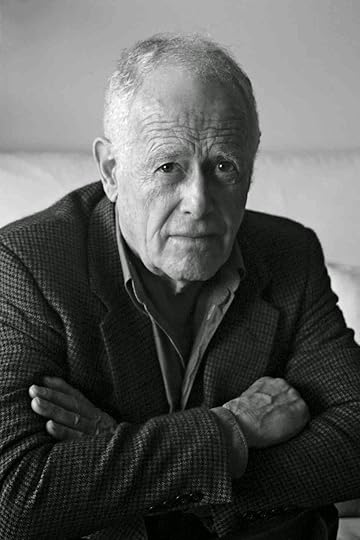 "Big name" authors brought into festivals don't always make themselves visible or available to the public. In fact, I've rarely been at one (or participated in one) where the keynote speaker appears much before or after his/her main event. That's understandable--they're not getting compensated for that time and they usually have other things to do. Understandable as it may be, I suspect this fact is sometimes still a little disappointing to festival attendees and participants alike.
"Big name" authors brought into festivals don't always make themselves visible or available to the public. In fact, I've rarely been at one (or participated in one) where the keynote speaker appears much before or after his/her main event. That's understandable--they're not getting compensated for that time and they usually have other things to do. Understandable as it may be, I suspect this fact is sometimes still a little disappointing to festival attendees and participants alike.
Ellusiveness was not the modus operandi of this year's F. Scott Fitzgerald Literary Festival's big name, however, which meant attendees and participating authors alike had ready access to James Salter. At Friday night's kick-off event, featuring 4 veteran authors and myself, James Salter sat in the front row. Exchanging a few words after the reading, he slipped his 80+-year-old hand into mind and looked at me. "I could stand to read more of your work," he smiled. "Impressive."
Did I blush? I must have, though I blush more now to admit that I'm not scholar of Salter's work. Brushing up on his background a bit over the course of the weekend, his compliment took on greater significance and I felt humbled, honored. Later, during his craft talk and "master class" at the festival, I was able to slip in a question. I asked James Salter how his imagination works. This is a question I always try to be able to answer for myself, as a fiction writer writing far from the realm of anything I've personally experienced, and so I'm always eager to hear how others address this topic as well.
I learned two things from James' answer: First, he, too, describes imagination as that thing we employ when we don't know the answer, or don't know what comes next. For me, it's the gateway (or perhaps the invitation) to write my way toward something I can believe in, toward a truth that feels authentic. To James, it's sometimes a clue that he needs to rely on other tools--the tools of his life experience--instead, or perhaps, more. When he spoke, James also used the word "invention," which I thought was particularly thought-provoking. He described having to imagine/invent information or moments in a novel in order to bring an idea to completion. But--and here's the second thing I learned--for an author such as as himself, imagination is secondary to "knowledge and observation." Knowledge and observation, James said, guide him through nearly everything he lives and writes. Because his fiction doesn't stray too terribly far from what he's experienced, that makes sense. But I had never thought of placing these three things--knowledge, observation, and imagination--on a spectrum before. I've lectured about where research meets imagination, but James' answer gave me more terms to work with and consider, adding good old fashioned "observation" back into the mix.
Observation, of course, is such a close friend to every writer that it's easy to forget it's a skill that comes in hand most especially during those long, silent, solo hours at the desk. For a writer, observation is always there, the logbook pages always filling, the "recorder" always ready to save impressions, and the eye always keen to those things others often miss. For most writers, I'd argue, observation is second nature; so essential to who we are, we don't even know how to separate ourselves from it.
Which is perhaps why, when I talk about research and imagination--my two main tools--I've forgotten to mention observation altogether. It's worth bringing this back into my consciousness, though, as my "war stories" are really just "people stories." And what do I observe day after day after day? People. How people behave is the gateway to the shared predicaments of the human heart, which--in my opinion--is a topic any story or novel must address, whether sideways or head-on.
 "Big name" authors brought into festivals don't always make themselves visible or available to the public. In fact, I've rarely been at one (or participated in one) where the keynote speaker appears much before or after his/her main event. That's understandable--they're not getting compensated for that time and they usually have other things to do. Understandable as it may be, I suspect this fact is sometimes still a little disappointing to festival attendees and participants alike.
"Big name" authors brought into festivals don't always make themselves visible or available to the public. In fact, I've rarely been at one (or participated in one) where the keynote speaker appears much before or after his/her main event. That's understandable--they're not getting compensated for that time and they usually have other things to do. Understandable as it may be, I suspect this fact is sometimes still a little disappointing to festival attendees and participants alike.Ellusiveness was not the modus operandi of this year's F. Scott Fitzgerald Literary Festival's big name, however, which meant attendees and participating authors alike had ready access to James Salter. At Friday night's kick-off event, featuring 4 veteran authors and myself, James Salter sat in the front row. Exchanging a few words after the reading, he slipped his 80+-year-old hand into mind and looked at me. "I could stand to read more of your work," he smiled. "Impressive."
Did I blush? I must have, though I blush more now to admit that I'm not scholar of Salter's work. Brushing up on his background a bit over the course of the weekend, his compliment took on greater significance and I felt humbled, honored. Later, during his craft talk and "master class" at the festival, I was able to slip in a question. I asked James Salter how his imagination works. This is a question I always try to be able to answer for myself, as a fiction writer writing far from the realm of anything I've personally experienced, and so I'm always eager to hear how others address this topic as well.
I learned two things from James' answer: First, he, too, describes imagination as that thing we employ when we don't know the answer, or don't know what comes next. For me, it's the gateway (or perhaps the invitation) to write my way toward something I can believe in, toward a truth that feels authentic. To James, it's sometimes a clue that he needs to rely on other tools--the tools of his life experience--instead, or perhaps, more. When he spoke, James also used the word "invention," which I thought was particularly thought-provoking. He described having to imagine/invent information or moments in a novel in order to bring an idea to completion. But--and here's the second thing I learned--for an author such as as himself, imagination is secondary to "knowledge and observation." Knowledge and observation, James said, guide him through nearly everything he lives and writes. Because his fiction doesn't stray too terribly far from what he's experienced, that makes sense. But I had never thought of placing these three things--knowledge, observation, and imagination--on a spectrum before. I've lectured about where research meets imagination, but James' answer gave me more terms to work with and consider, adding good old fashioned "observation" back into the mix.
Observation, of course, is such a close friend to every writer that it's easy to forget it's a skill that comes in hand most especially during those long, silent, solo hours at the desk. For a writer, observation is always there, the logbook pages always filling, the "recorder" always ready to save impressions, and the eye always keen to those things others often miss. For most writers, I'd argue, observation is second nature; so essential to who we are, we don't even know how to separate ourselves from it.
Which is perhaps why, when I talk about research and imagination--my two main tools--I've forgotten to mention observation altogether. It's worth bringing this back into my consciousness, though, as my "war stories" are really just "people stories." And what do I observe day after day after day? People. How people behave is the gateway to the shared predicaments of the human heart, which--in my opinion--is a topic any story or novel must address, whether sideways or head-on.
Published on October 20, 2014 05:00
October 16, 2014
F. Scott Fitzgerald Literary Festival
Reading in our nation's capital has privately been in the back of my mind ever since Flashes of War released almost a year and a half ago. This weekend, I'm happy I'll be in that area for a series of public events. If you know writers, readers, or--most especially--veterans in the area, please share this information with them.
Join me and fellow war lit authors Ron Capps, Dario DiBattista, James Matthews, and Kayla Williams this Friday, October 17 at 7 p.m. for a free, public reading and conversation, "Writing the War Experience" to kick off the 17th annual F. Scott Fitzgerald Literary Festival. Read more about this awesome festival in The Washington Post (and contrary to what they published, no, I'm not a veteran.)
Register for my one-hour writing workshop, "What is Flash Fiction & How Can it Improve Short Stories & Novels?" at the Rockville Memorial Library. Class meets 10am-11am and 4pm-5pm on Saturday, October 18 and more information can be found here.
Meet the Loyola University Maryland's publisher at Apprentice House, Kevin Atticks--and join us both for a reading and conversation Monday, October 20th at 7pm in Baltimore, Maryland at The Ivy Bookshop. Free and open to the public.
Join me and fellow war lit authors Ron Capps, Dario DiBattista, James Matthews, and Kayla Williams this Friday, October 17 at 7 p.m. for a free, public reading and conversation, "Writing the War Experience" to kick off the 17th annual F. Scott Fitzgerald Literary Festival. Read more about this awesome festival in The Washington Post (and contrary to what they published, no, I'm not a veteran.)
Register for my one-hour writing workshop, "What is Flash Fiction & How Can it Improve Short Stories & Novels?" at the Rockville Memorial Library. Class meets 10am-11am and 4pm-5pm on Saturday, October 18 and more information can be found here.
Meet the Loyola University Maryland's publisher at Apprentice House, Kevin Atticks--and join us both for a reading and conversation Monday, October 20th at 7pm in Baltimore, Maryland at The Ivy Bookshop. Free and open to the public.
Published on October 16, 2014 05:00
October 13, 2014
Jogging Writer: Tips for First 5K
I knew I needed to run slow. I knew the rush at the start would make my breathing ragged for the first few minutes. Secretly, I feared I'd come in last. As it turned out, what I knew or thought I knew didn't matter one bit once my body eclipsed my mind. Such strange relief--after five weeks working 10-hour days, often 6 days a week, something else was telling me what to do. I liked it.
To be sure, I did entertain clear thoughts: Be careful on this footbridge because it rained last night. Step on these rocks to cross the creek, rather than going through the water. Save yourself for the final uphill. But for the most part, those tips came to me from a hopeful and wise voice inside--nothing demanding about it. This was the first race of my life, after all, and in the face of plantar fasciatis that allowed me only 4 runs in the last 8 weeks (with a 93-mile backpacking trip in between), I had mixed feelings about competing. Originally, I set a goal of coming in around 30 minutes for the 3.1 miles. In the wake of the injury, I decided 35:00 would be more fair, as I didn't want to set myself up for failure on my first timed event.
The bell rang and off we went! Within the first 1/10 of a mile, I was nearly alone on the trail. Two kids ran behind me, somewhere. Ahead, I saw a woman wearing pink, her impossibly toned thighs and thin waist a marvel of smooth skin and fabric. Just ahead of her, darting into the woods, was the spandex ninja--a tall, lean man with gray hair and all-black race clothes. I reasoned I wouldn't see him again until I crossed the finish line. It wasn't long before the woman in pink dipped out of sight and I was alone in the woods, absolutely certain there were no other adults behind me on the trail.
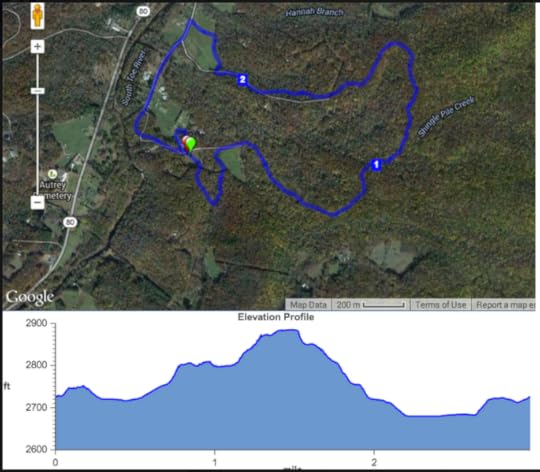 AMS Fall Foliage 5K 2014
AMS Fall Foliage 5K 2014
The terrain was familiar, old single-track trails and logging roads in the South Toe Valley where I typically run anyway. But the adrenaline rush, the 33 other runners, and even the early morning hour were not familiar, and while I mostly enjoyed myself, I also faught to calm my nerves. Dad had given me great advice before we took off: "Just breathe. Just beat one person." I liked that. One person. Surely I could beat one person, right? While I knew enough to know most runners are in it to beat their own personal best or personal performance, it's also a competitive sport by nature. Even the humblest racer hopes to beat one person. The other advice I received came by way of Thrive magazine, which suggested envisioning the butterflies in my stomach in the shape of a chevron. I took that visualization one step further and pointed the chevron outwards and forward from my belly. If ever there was a time I slowed, I only had to conjure the furiously flapping butterflies and let them tug me along. And tug, they did.
The other thing about the terrain, and this relates to my pace--this was a trail run: 3 creek crossings, 2 grassy fields, 200 feet of elevation gain on rocky terrain, and a few old gravel roads connecting it all. Hardly impossible, but not a treadmill, either. Given this, and aforementioned plantar fasciatis, I felt good when I came in with a time of 32:12. But I'm getting ahead of myself...
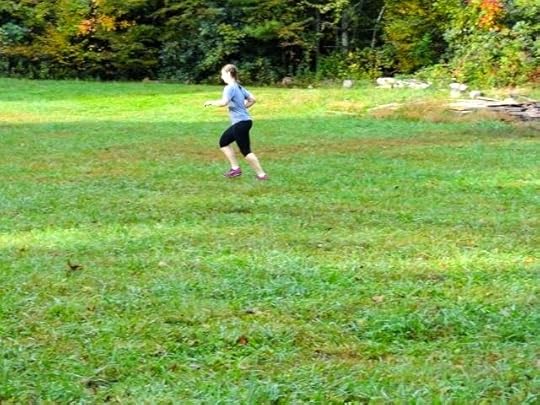 Curvy and slow, but off I go!About 3/4 of a mile in, I rounded a bend in the trail and glimpsed the woman in pink. Beyond her, perhaps 1/10 of a mile further, the ninja darted in and out of sight. Slow as a two-ton train, I passed the woman and puttered uphill. Surely she was the mother of one of the children flailing behind me. Passing her was no victory; she had to be a sympathy runner. With thighs like that, I couldn't imagine any other reason she'd be moving slower than me. I spent the next mile and half completely alone, no ninja in sight. I had no intention of passing him, but his presence did give me mild reassurance I was at least running the right direction.
Curvy and slow, but off I go!About 3/4 of a mile in, I rounded a bend in the trail and glimpsed the woman in pink. Beyond her, perhaps 1/10 of a mile further, the ninja darted in and out of sight. Slow as a two-ton train, I passed the woman and puttered uphill. Surely she was the mother of one of the children flailing behind me. Passing her was no victory; she had to be a sympathy runner. With thighs like that, I couldn't imagine any other reason she'd be moving slower than me. I spent the next mile and half completely alone, no ninja in sight. I had no intention of passing him, but his presence did give me mild reassurance I was at least running the right direction.
With help from cheering fans at trail junctures along the way, and Mom, Dad, and Brad surprising me at the red barn by the cows, I made it toward the home stretch. One hill lay before me and it was no easier than I thought it might be. That finished, I heard cheering at the finish line through the woods and the end came into the view. The ninja had finished not too terribly ahead of me, as I could hear the cheering when he completed his race. Another runner--someone who had finished much faster than I--was actually running the opposite direction of the race and high-fiving people. I reached up to high-five him and, startlingly close behind me, heard another slap of skin on skin.
The woman in pink? I couldn't be sure. I leapt over the mud puddle and ran through the first set of orange cones at the finish. Onlookers cheered and I slowed to a stop. "No, no!" someone called, "Keep GOING!" Confused, I realized the onlookers were at the start of the final stretch and the finish line lay some thirty meters ahead. I let loose an ungraceful, loud, "FUCK!" and sprinted across the proper finish line. About forty-five seconds later, the woman in pink crossed as well.
I learned so much--and I'll have to paraphrase here--but more than anything, I understood immediately that the race you run is the race in your mind. I had convinced myself the ninja had magical powers when in fact he was a 60+ former competitive runner. I was certain only two kids and the woman in pink were behind me, when in fact I came in 24th out of 33 overall. And the woman in pink? Hardly a mother. Like me, it was her first race. She was a twenty-something from Charlotte training for her first half marathon. We high-fived at the end and she shook her head. "I couldn't catch you," she said. Did I smile? Maybe. But I told her good job, at any rate, and I meant it.
While the 5K was fun, I'm not sure it's my ideal distance. I enjoy running slowly and for long periods. If healing continues, I'm hoping for a 10K in November and a 1/2 marathon in March. Perhaps a 5K here and there for training, but mostly I'm interested in the slow and steady. How will it all pan out? Only one way to know...
To be sure, I did entertain clear thoughts: Be careful on this footbridge because it rained last night. Step on these rocks to cross the creek, rather than going through the water. Save yourself for the final uphill. But for the most part, those tips came to me from a hopeful and wise voice inside--nothing demanding about it. This was the first race of my life, after all, and in the face of plantar fasciatis that allowed me only 4 runs in the last 8 weeks (with a 93-mile backpacking trip in between), I had mixed feelings about competing. Originally, I set a goal of coming in around 30 minutes for the 3.1 miles. In the wake of the injury, I decided 35:00 would be more fair, as I didn't want to set myself up for failure on my first timed event.
The bell rang and off we went! Within the first 1/10 of a mile, I was nearly alone on the trail. Two kids ran behind me, somewhere. Ahead, I saw a woman wearing pink, her impossibly toned thighs and thin waist a marvel of smooth skin and fabric. Just ahead of her, darting into the woods, was the spandex ninja--a tall, lean man with gray hair and all-black race clothes. I reasoned I wouldn't see him again until I crossed the finish line. It wasn't long before the woman in pink dipped out of sight and I was alone in the woods, absolutely certain there were no other adults behind me on the trail.
 AMS Fall Foliage 5K 2014
AMS Fall Foliage 5K 2014The terrain was familiar, old single-track trails and logging roads in the South Toe Valley where I typically run anyway. But the adrenaline rush, the 33 other runners, and even the early morning hour were not familiar, and while I mostly enjoyed myself, I also faught to calm my nerves. Dad had given me great advice before we took off: "Just breathe. Just beat one person." I liked that. One person. Surely I could beat one person, right? While I knew enough to know most runners are in it to beat their own personal best or personal performance, it's also a competitive sport by nature. Even the humblest racer hopes to beat one person. The other advice I received came by way of Thrive magazine, which suggested envisioning the butterflies in my stomach in the shape of a chevron. I took that visualization one step further and pointed the chevron outwards and forward from my belly. If ever there was a time I slowed, I only had to conjure the furiously flapping butterflies and let them tug me along. And tug, they did.
The other thing about the terrain, and this relates to my pace--this was a trail run: 3 creek crossings, 2 grassy fields, 200 feet of elevation gain on rocky terrain, and a few old gravel roads connecting it all. Hardly impossible, but not a treadmill, either. Given this, and aforementioned plantar fasciatis, I felt good when I came in with a time of 32:12. But I'm getting ahead of myself...
 Curvy and slow, but off I go!About 3/4 of a mile in, I rounded a bend in the trail and glimpsed the woman in pink. Beyond her, perhaps 1/10 of a mile further, the ninja darted in and out of sight. Slow as a two-ton train, I passed the woman and puttered uphill. Surely she was the mother of one of the children flailing behind me. Passing her was no victory; she had to be a sympathy runner. With thighs like that, I couldn't imagine any other reason she'd be moving slower than me. I spent the next mile and half completely alone, no ninja in sight. I had no intention of passing him, but his presence did give me mild reassurance I was at least running the right direction.
Curvy and slow, but off I go!About 3/4 of a mile in, I rounded a bend in the trail and glimpsed the woman in pink. Beyond her, perhaps 1/10 of a mile further, the ninja darted in and out of sight. Slow as a two-ton train, I passed the woman and puttered uphill. Surely she was the mother of one of the children flailing behind me. Passing her was no victory; she had to be a sympathy runner. With thighs like that, I couldn't imagine any other reason she'd be moving slower than me. I spent the next mile and half completely alone, no ninja in sight. I had no intention of passing him, but his presence did give me mild reassurance I was at least running the right direction.With help from cheering fans at trail junctures along the way, and Mom, Dad, and Brad surprising me at the red barn by the cows, I made it toward the home stretch. One hill lay before me and it was no easier than I thought it might be. That finished, I heard cheering at the finish line through the woods and the end came into the view. The ninja had finished not too terribly ahead of me, as I could hear the cheering when he completed his race. Another runner--someone who had finished much faster than I--was actually running the opposite direction of the race and high-fiving people. I reached up to high-five him and, startlingly close behind me, heard another slap of skin on skin.
The woman in pink? I couldn't be sure. I leapt over the mud puddle and ran through the first set of orange cones at the finish. Onlookers cheered and I slowed to a stop. "No, no!" someone called, "Keep GOING!" Confused, I realized the onlookers were at the start of the final stretch and the finish line lay some thirty meters ahead. I let loose an ungraceful, loud, "FUCK!" and sprinted across the proper finish line. About forty-five seconds later, the woman in pink crossed as well.
I learned so much--and I'll have to paraphrase here--but more than anything, I understood immediately that the race you run is the race in your mind. I had convinced myself the ninja had magical powers when in fact he was a 60+ former competitive runner. I was certain only two kids and the woman in pink were behind me, when in fact I came in 24th out of 33 overall. And the woman in pink? Hardly a mother. Like me, it was her first race. She was a twenty-something from Charlotte training for her first half marathon. We high-fived at the end and she shook her head. "I couldn't catch you," she said. Did I smile? Maybe. But I told her good job, at any rate, and I meant it.
While the 5K was fun, I'm not sure it's my ideal distance. I enjoy running slowly and for long periods. If healing continues, I'm hoping for a 10K in November and a 1/2 marathon in March. Perhaps a 5K here and there for training, but mostly I'm interested in the slow and steady. How will it all pan out? Only one way to know...
Published on October 13, 2014 05:00



